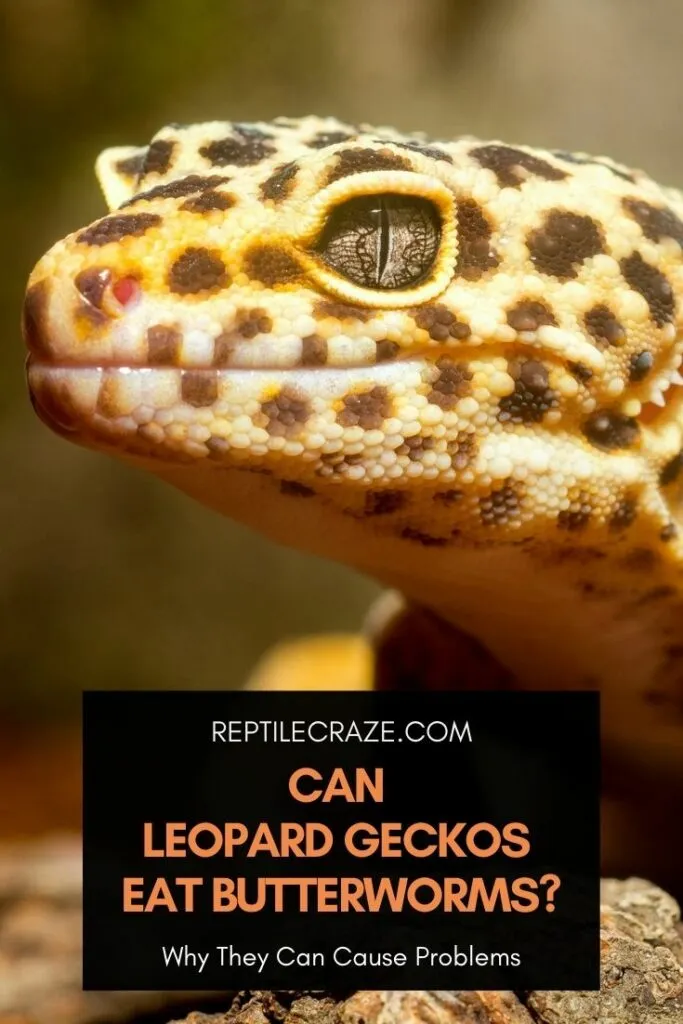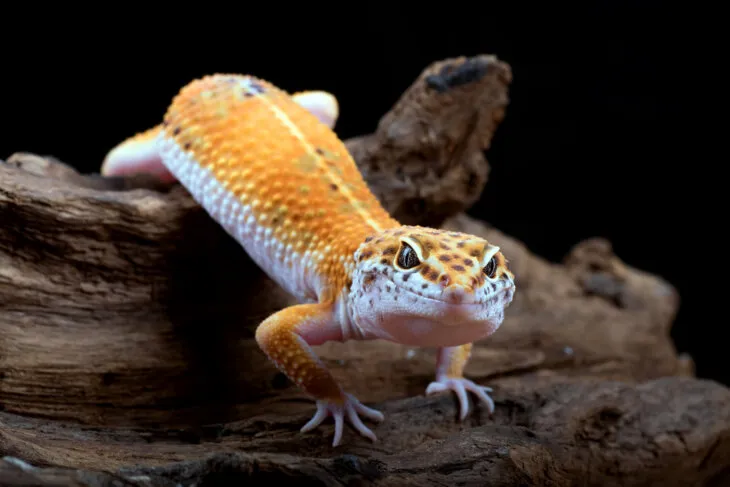
Experts recommend feeding leopard geckos a varied live
Butterworms are safe for leopard geckos to eat. However, it’s best to reserve butterworms as an occasional treat due to their high-fat content. Butterworms might also cause leopard geckos to regurgitate because they’re heavy on the geckos’ digestive systems.
This article will focus on the positives and negatives of feeding leopard geckos butterworms, along with feeding guidelines. There’s also a section on alternative live feed options that might be a better option nutritionally.
Table of Contents
It Is Safe To Feed Leopard Geckos Butterworms
Leopard geckos are opportunistic predators by nature. That means, in the wild, they eat what’s available and easiest to hunt.
It’s not uncommon for them to eat insects like beetles, locusts, springtails, etc. They’re strict insectivores and don’t eat fruits or vegetables.
In captivity, the reptiles show the most preference for feeder insects like dubia roaches, crickets, and mealworms. But, a hungry leopard gecko will not hesitate to go after live butterworms because that’s what its diet involves.
Butterworms (Chilecomadia moorei) are larvae of the Chilean Moth and are native to Chile. The country exports them as fishing bait and reptile
Leopard gecko owners add butterworms to their reptiles’ diet because they’re a good source of protein and vitamins. Additionally, butterworms aren’t fast-movers, making them easier for leopard geckos to hunt.
The only downside to feeding butterworms to leopard geckos is their high-fat content. That’s why butterworms make better treats instead of a staple feeder option.
There have been reports of leopard geckos regurgitating butterworms, but this likely has more to do with the gecko being unable to digest the worm than anything else.
The Pros And Cons Of Feeding Leopard Geckos Butterworms
Leopard gecko owners looking to introduce butterworms to their pets’ diet will need to balance the pros and cons to arrive at an informed decision.
The good news is we’ve done most of the heavy-lifting by devising a list of positives and negatives for you to go through:
Pros
- The high protein content of butterworms can help in areas of muscle building and maintenance, cell repair, organ function, and other physiological functions.
- Butterworms are rich in fat, making them ideal for leopard geckos suffering from weight loss or illness.
- Feeding your leopard gecko butterworms can help promote absorption of vitamins A, K, D, E due to fatty acids.
- Feeding butterworms to leopard geckos can help create fat stores for energy-draining events like egg-laying.
- Butterworms can be stored in refrigerator for up to two months in a container with sawdust substrate.
Cons
- Feeding healthy leopard geckos butterworms too often can lead to obesity very quickly.
- Butterworms can sometimes be a little heavy on a leopard gecko’s digestion, leading to regurgitation.
- Butterworms only eat from the Trevo plant and can’t be gut-loaded.
- Not all leopard geckos like taste of butterworms.
- Butterworms are generally nutritionally beneficial for underweight or sick leopard geckos.
- Can be a little difficult to obtain at times due to shortages of Trevo leaves.
What Is The Nutritional Value Of Butterworms?
Butterworms are exclusively fed on the Trevoa trenervis (or the Trevo plant) that grows in Chile. That’s why butterworms are imported and difficult to raise in captivity.
The nutrients butterworms derive from the Trevo plant remain a mystery. Thankfully, the nutritional value of butterworms is known and is as follows:
| Insect | Butterworms |
| Moisture (%) | 60.2 |
| Fat (%) | 29.4 |
| Protein (%) | 15.5 |
| Ash (%) | 0.8 |
| Fiber (%) | 1.4 |
| Calcium (mg/kg) | 125 |
| Phosphorus (mg/kg) | 2250 |
| Thiamin (mg/kg) | 0.7 |
Leopard geckos in their natural habitat derive moisture from what they eat. But, in captivity, owners generally provide a water source for their reptiles to drink from.
Nonetheless, feeding your gecko moisture-rich butterworms can help sustain hydration levels. This is even more true if your reptile is recovering from a bout of dehydration.
Butterworms pack in a healthy protein and fat punch. That makes them very useful for underweight or recovering leopard geckos.
How Many Butterworms Should You Feed A Leopard Gecko?
There’s no set formula to help you figure out how many butterworms you should feed your leopard gecko. That’s because you have to consider factors like your reptile’s health, weight, and like or dislike of butterworms.
A good rule of thumb for feeding butterworms to healthy leopard geckos is 2 to 3 worms, once a week.
On the other hand, if your leopard gecko is underweight or recovering from a bout of illness, you can increase the feedings from once to twice or thrice a week, depending on how well your gecko does.
It’s always best to start small when introducing a new feeder type in your leopard gecko’s diet. Doing so will help avoid any digestion concerns and allow you to slowly increase the intake if there’s a need for it.
It’s also a good idea to dust the butterworms with calcium since they have a higher phosphorous content compared to calcium.

Where To Buy Butterworms For Leopard Geckos?
Buying feeders online can be an intimidating experience for first-timers because of the considerations involved. For example, the need for live arrival guarantees, bulk buying vs. small purchases, and of course, quality control.
Thankfully, there are plenty of reliable sellers online that gecko owners can turn to for buying butterworms. These include Josh’s Frogs, Backwater Reptiles, Rainbow Mealworms, etc.
Buyers thinking of purchasing butterworms online should take some time to survey pricing, guarantees, and testimonials to ensure all bases are covered.
Are There Better Alternatives Than Butterworms?
Research indicates that diet manipulation can lead to different developmental outcomes, such as accelerated growth.
That’s why experts recommend a diverse live
Butterworms aren’t a good staple feeder option because they’re high in fats and can lead to obesity if fed in excess or regularly.
There are several other alternatives leopard gecko owners can rely on that offer a more suitable nutritional breakdown. These include:
Tip: We have a huge guide on the best worms for leopard geckos here!
Crickets
Most leopard geckos like the taste of crickets and don’t mind hunting them down.
Besides offering the thrill of a chase, crickets are also highly nutritious and contain barely any fat, making them more suitable for daily feedings.
| Insect | Butterworms | Crickets |
| Moisture (%) | 60.2 | 77.1 |
| Fat (%) | 29.4 | 3.3 |
| Protein (%) | 15.5 | 15.4 |
| Ash (%) | 0.8 | 1.1 |
| Fiber (%) | 1.4 | 2.2 |
| Calcium (mg/kg) | 125 | 275 |
| Phosphorus (mg/kg) | 2250 | 2520 |
| Thiamin (mg/kg) | 0.7 | 0.4 |
Dubia Roaches
Dubia roaches can offer leopard geckos the best of both worlds because they have a high protein content and barely any fat, making them ideal as a staple.
Additionally, dubia roaches can’t climb out of gecko enclosures, making them easier for your leopard gecko to hunt. (Read more on dubia roaches as feeder insects for leopard geckos here)
| Insect | Butterworms | Dubia Roaches |
| Moisture (%) | 60.2 | 66 |
| Fat (%) | 29.4 | 7.2 |
| Protein (%) | 15.5 | 23 |
| Ash (%) | 0.8 | 1.2 |
| Fiber (%) | 1.4 | 2.9 |
| Calcium (mg/kg) | 125 | 800 |
| Phosphorus (mg/kg) | 2250 | 2250 |
| Thiamin (mg/kg) | 0.7 | n/a |
Mealworms
Mealworms boast a sizable protein quotient with not even half the fat in butterworms. Plus, the majority of leopard geckos seem to like their taste.
The only downside to these feeder worms is that they have a lot of chitin and can lead to digestive problems or impaction if fed too often or in excess – we explain that here.
| Insect | Butterworms | Mealworms |
| Moisture (%) | 60.2 | 61.9 |
| Fat (%) | 29.4 | 13.4 |
| Protein (%) | 15.5 | 18.7 |
| Ash (%) | 0.8 | 0.9 |
| Fiber (%) | 1.4 | 2.5 |
| Calcium (mg/kg) | 125 | 169 |
| Phosphorus (mg/kg) | 2250 | 2950 |
| Thiamin (mg/kg) | 0.7 | 0.2 |
Conclusion
Leopard geckos thrive on a mixed diet that offers protein, fat, fiber, and ash to cater to their overall dietary needs.
That’s why it’s best to think of butterworms as infrequent snacks for healthy geckos. Although, if your leopard gecko is underweight, you can steadily increase its intake of butterworms until it achieves a healthy number.
- Enchi Ball Python: A Unique and Stunning Morph of Python regius - March 27, 2025
- Emerald Tree Monitor: The Enigmatic Green Guardian of the Rainforest - March 26, 2025
- The Egyptian Cobra (Naja haje): A Fascinating Serpent - March 25, 2025
